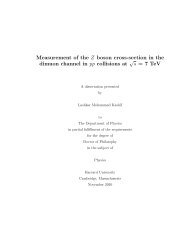2 The CDF Experiment at Fermilab Contents - Harvard University ...
2 The CDF Experiment at Fermilab Contents - Harvard University ...
2 The CDF Experiment at Fermilab Contents - Harvard University ...
You also want an ePaper? Increase the reach of your titles
YUMPU automatically turns print PDFs into web optimized ePapers that Google loves.
90 Section 2: <strong>CDF</strong> Physics Analysis<br />
Bs<br />
Ds K<br />
φ<br />
π<br />
K K<br />
Other B Decay (used for tagging)<br />
000 111<br />
000 111<br />
000 111<br />
000 111<br />
Primary Vertex<br />
Bs<br />
Ds<br />
Fragment<strong>at</strong>ion K (used for tagging)<br />
K<br />
Figure 43: Diagram of the B s ! D s K; D s ! ; ! KK decay, including fragment<strong>at</strong>ion<br />
K and opposite side B used for avor tagging.<br />
Measuring sin with B s ! D s K<br />
Bailey has performed a feasibility study for measuring sin using the decay mode B s !<br />
Ds K <strong>at</strong> <strong>CDF</strong> II. Since then, he and Maksimovic have improved this study and presented<br />
it to the collabor<strong>at</strong>ion. This mode is unique to hadronic colliders (the B factories do not<br />
produce B s ) and thus provides an important complement to studies using B 0 . It also has the<br />
benet of not involving \penguin" diagrams which make many CP viol<strong>at</strong>ion measurements<br />
ambiguous through their non-CP viol<strong>at</strong>ing contributions. With a rel<strong>at</strong>ively large decay r<strong>at</strong>e,<br />
B s ! Ds K is one of the best decay modes for measuring sin which is necessary for the<br />
full consistency check of the Standard Model.<br />
<strong>The</strong> theoretically expected errors are inversely proportional to a variety of dilution factors<br />
which eectively reduce the amplitude of the signal observed. <strong>The</strong>se dilution factors arise<br />
from measurement resolutions, backgrounds, t limit<strong>at</strong>ions, and avor tagging ineciencies<br />
and mistags. Using the l<strong>at</strong>est <strong>CDF</strong> II estim<strong>at</strong>es for these dilutions the expected error on<br />
sin is 0.45.<br />
To check the dependence of this measurement upon various input parameters, Bailey<br />
wrote a toy Monte Carlo simul<strong>at</strong>ion and likelihood tter including backgrounds, resolution<br />
eects, and mistag probabilities. <strong>The</strong> measurement involves an unbinned likelihood t to<br />
four dierent decay r<strong>at</strong>es (both B s and B s to both D s , K + and D s + K , ) to extract the weak<br />
phase , a strong phase, and the r<strong>at</strong>io of the decay r<strong>at</strong>es. <strong>The</strong> input parameters to the event<br />
gener<strong>at</strong>ion and t were varied and the resulting error on sin was studied. It was found<br />
to scale as expected by theory. Figure 45 (left) shows the expected error as a function of<br />
the B s mixing parameter x s = m s =,. <strong>The</strong> current limit on m s is 10:2ps ,1 [26], but















